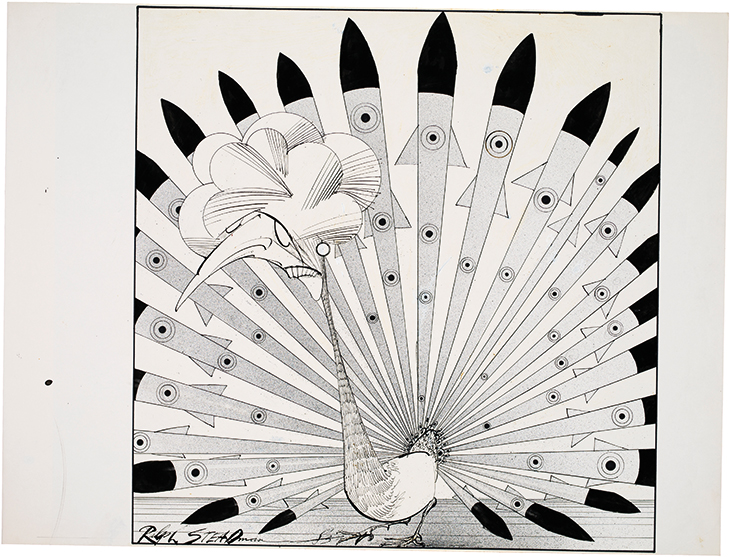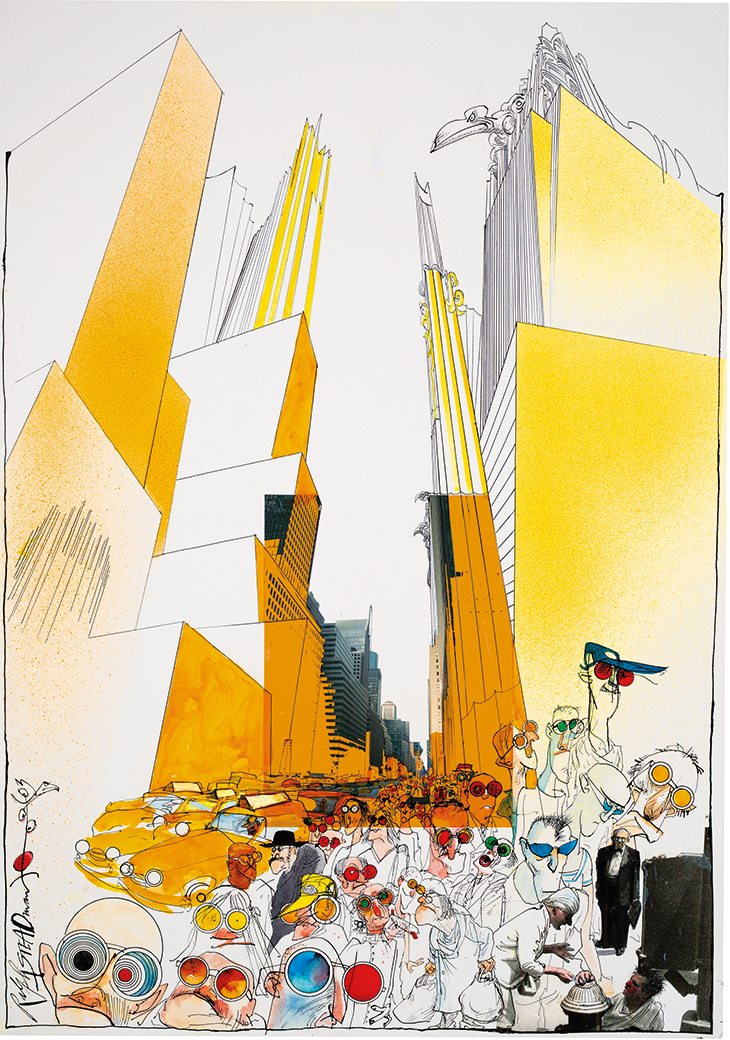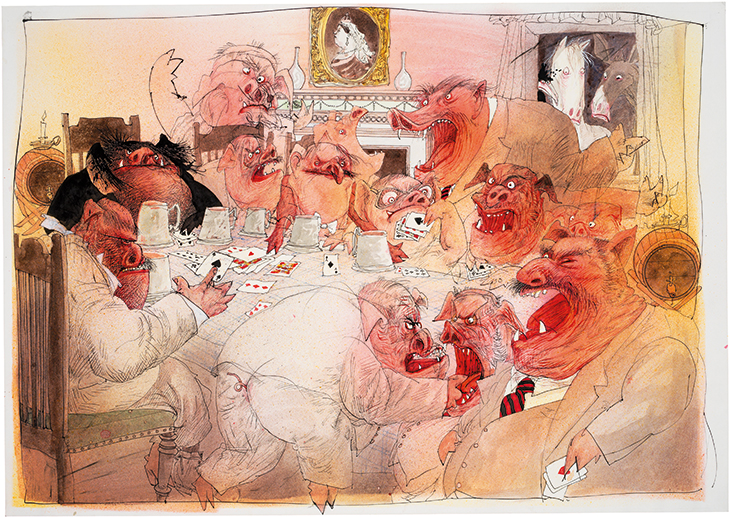Ralph Steadman is a rare thing, a celebrity illustrator. His fame goes hand in hand with that of Hunter S. Thompson, for whose novel Fear and Loathing in Las Vegas (1971) he drew the cover and other illustrations. It’s hard to imagine a reprint without Steadman’s ink drawing of Raoul Duke and Dr Gonzo driving out across the desert. Steadman’s depiction of the two characters as grotesque and twisted madmen and his rendering of the book’s title in scrawled, inky capitals chime perfectly with Thompson’s writing. Even when it was adapted into a film in 1998 – starring Johnny Depp as Duke, Thompson’s alter ego – Steadman’s handwriting was still used for the poster alongside Depp’s contorted face.
 Steadman has worked as an illustrator for most of his life, and this career has been drawn together in A Life in Ink, a mainly pictorial retrospective. He was born in Merseyside in 1936, and started working as an illustrator while doing his national service, meanwhile learning technical drawing and completing a correspondence course in drawing with Percy V. Bradshaw’s Press Art School (Bradshaw was a successful illustrator in the first half of the 20th century). He left the RAF in 1956 and pursued a career as a newspaper cartoonist for the next decade and a half, taking time to study art at the London College of Printing and Graphic Arts. In 1970 he travelled to New York, where he met the editor who sent him to illustrate Thompson’s coverage of the Kentucky Derby for Scanlan’s Monthly magazine. The commission was the start of the friendship that defined Steadman’s career: as Steadman explains in the Q&A that accounts for much of the text in A Life in Ink, ‘It became central to everything I did really. Of all the people in America, he was the one I should meet, had to meet.’
Steadman has worked as an illustrator for most of his life, and this career has been drawn together in A Life in Ink, a mainly pictorial retrospective. He was born in Merseyside in 1936, and started working as an illustrator while doing his national service, meanwhile learning technical drawing and completing a correspondence course in drawing with Percy V. Bradshaw’s Press Art School (Bradshaw was a successful illustrator in the first half of the 20th century). He left the RAF in 1956 and pursued a career as a newspaper cartoonist for the next decade and a half, taking time to study art at the London College of Printing and Graphic Arts. In 1970 he travelled to New York, where he met the editor who sent him to illustrate Thompson’s coverage of the Kentucky Derby for Scanlan’s Monthly magazine. The commission was the start of the friendship that defined Steadman’s career: as Steadman explains in the Q&A that accounts for much of the text in A Life in Ink, ‘It became central to everything I did really. Of all the people in America, he was the one I should meet, had to meet.’
Steadman’s drawing for the opening spread of Thompson’s piece for Scanlan’s (The Kentucky Derby, Winner’s Circle, 1970) shows a bloated, squat man in a poorly fitting suit, with a cigar dangling from his mouth and his weight seemingly hanging drunkenly from the reins of the elegant horse that towers over him. Presumably he is the owner of the horse, taking pride in owning this champion, but Steadman gives him no credit for that: he is clinging to the horse metaphorically, as well as to stop himself collapsing on to the ground.

Tor-Peacock! (1983), Ralph Steadman. © Ralph Steadman Art Collection
Throughout his career, Steadman has shown contempt for those in authority. In a piece from 1983 titled Tor-Peacock! Margaret Thatcher’s gaunt face sits on top of a peacock’s neck, tail fanned out as an array of missiles. This may allude to Thatcher’s engagement in the Falklands War, a factor in her victory in the 1983 general election, but one of the problems with the book is a lack of context. Steadman’s role in most of these pieces is that of an illustrator, working for clients on commissions and responding to events or personalities; knowing what he is responding to is important. Occasionally a quote from Steadman runs alongside the works, but these texts amount to very little. The Trial of Lisl Auman (2004), for example, shows a small, meek-looking woman beneath a towering judge’s bench; on either side are galleries of equally towering, animalistic personalities shouting ‘Put her away!!’ and ‘No mercy!’, while Hunter S. Thompson stands passively at the back of one gallery. The only explanation offered is a quote from Steadman under the image: ‘Hunter thought it was a travesty of justice.’ Readers are offered no background information on the case of Lisl Auman, who in 1998 was convicted through a bizarre Colorado state law for a murder committed by someone else while she sat in a police car. Nor are readers given an idea of whether this piece was commissioned to go alongside Thompson’s writing: he wrote about Lisl Auman for Vanity Fair in 2004 after she contacted him from prison; presumably Steadman was commissioned to illustrate this piece.

Street Scene, New York (2000), Ralph Steadman. © Ralph Steadman Art Collection
Many images need no explanation though. Street Scene, New York (2000) is a fantastic depiction of a crowded and manic sidewalk in Manhattan. The high-rises, shown with simple, straight, sharp lines (a product of Steadman’s background in technical drawing), tower above tightly packed, bizarre personalities united by their wearing of glasses of all types, to shield themselves from the bright yellow sunlight hitting the glass sides of the buildings. The result is a claustrophobic depiction of a hot day, with a moment of stillness coming from an elderly person apparently offering assistance to a man on the floor near a fire hydrant. These two, along with an old man in a suit who watches them, are the only people drawn with sensitivity rather than the characteristic bizarrely enlarged features that Steadman has given to everyone on the sidewalk. A depiction of the closing scene of Orwell’s Animal Farm, in which the ruling pigs take on the features of the humans they displaced, is a perfect example of Steadman’s take on those in authority: the obese pigs shout at one another with wild eyes and sharp white teeth in their wide-open mouths. In tableaux like this Steadman’s work is reminiscent of George Grosz.

The Pigs Become Men, The Enemy Within (1995), Ralph Steadman. © Ralph Steadman Art Collection
Just as the opportunity is missed to put some of Steadman’s works into their contemporary contexts, so another is missed to talk about his place in the history of art. His depictions of crowds often have a chaotic and gruesome tone reminiscent of James Ensor’s crowds of masked figures: Ensor’s satirical Christ’s Entry into Brussels in 1889, for instance, has a frantic depiction of a crowd similar to Street Scene, New York, with everyone following a self-important, puffed-up clown of a bishop, rather than Christ, who seems to be disregarded by both the bishop and the crowd. But beyond a short introduction and the not particularly insightful Q&A, Steadman’s work isn’t really given much context at all. A discussion of his legacy as an artist has to stretch further than his connection to Hunter S. Thompson. I don’t think it would suffer as a result.
Ralph Steadman: A Life in Ink by Steve Crist and Sadie Steadman Williams (eds.) is published by Chronicle Chroma.
From the January 2021 issue of Apollo. Preview and subscribe here.














![Masterpiece [Re]discovery 2022. Photo: Ben Fisher Photography, courtesy of Masterpiece London](http://zephr.apollo-magazine.com/wp-content/uploads/2022/07/MPL2022_4263.jpg)
Suzanne Valadon’s shifting gaze